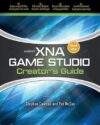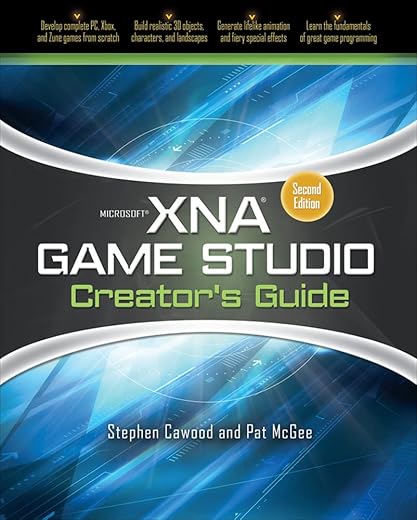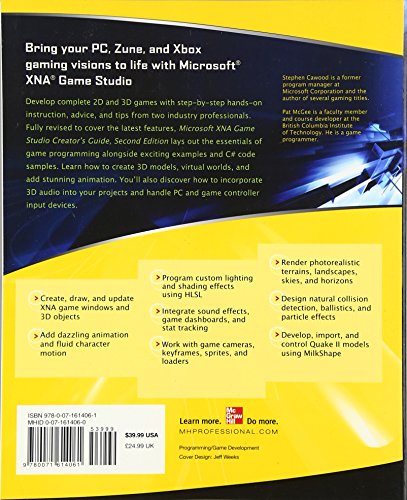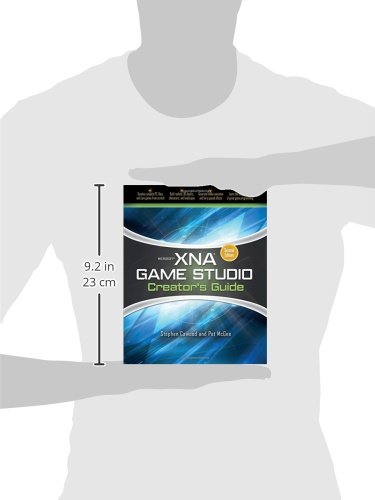
Original price was: €50.00.€28.20Current price is: €28.20.
Microsoft XNA Game Studio Creator’s Guide, Second Edition by Stephen Cawood and Pat McGee Price comparison
Microsoft XNA Game Studio Creator’s Guide, Second Edition by Stephen Cawood and Pat McGee Price History
Microsoft XNA Game Studio Creator’s Guide, Second Edition by Stephen Cawood and Pat McGee Description
Microsoft XNA Game Studio Creator’s Guide, Second Edition Review
Unlock your game development potential with the Microsoft XNA Game Studio Creator’s Guide, Second Edition by Stephen Cawood and Pat McGee. Ideal for aspiring game developers and experienced programmers alike, this comprehensive guide offers an in-depth exploration of the XNA framework, ensuring you have the tools you need to create stunning games. Whether you are learning game design or looking to elevate your existing skills, this essential resource will help you navigate successfully through the world of game development.
Key Features of the Microsoft XNA Game Studio Creator’s Guide
- Comprehensive Content: Covering 560 pages, the guide delves into various aspects of game development using XNA, making it suitable for both beginners and seasoned developers.
- Hands-On Approach: The book provides numerous examples, exercises, and projects to enhance your learning experience and facilitate real-world application.
- Updated Content: As the second edition published in May 2009, this guide offers the latest techniques and practices for developing games using the XNA framework.
- Expert Authors: Written by well-regarded experts in the field, Stephen Cawood and Pat McGee, whose insights and experiences enrich the content significantly.
- Accessible Language: The book is written in English and is easy to understand, allowing readers from various backgrounds to grasp complex concepts effortlessly.
- ISBN Information: This edition can be easily identified with ISBN-10: 9780071614061 and ISBN-13: 978-0071614061.
Price Comparison Across Different Suppliers
When it comes to finding the best price for the Microsoft XNA Game Studio Creator’s Guide, variations among retailers can dramatically impact your purchase decision. With our price comparison tool, you can effortlessly discover how prices measure up across several suppliers. Enjoy significant savings by shopping around.
Notable Trends from the Price History Chart
Examining the 6-month price history for this book reveals interesting trends. On average, the price has fluctuated slightly, with minimal dips during sales events. This data suggests now may be an excellent time to buy if you notice a price increase on the horizon.
Customer Reviews Summary
Customer reviews for the Microsoft XNA Game Studio Creator’s Guide highlight its effectiveness as a learning tool. Many readers commend the guide for its thorough explanations and practical examples. Users have reported success in applying the concepts learned in the book to their own game projects.
However, some drawbacks were noted. A few reviewers mentioned that the book could benefit from more advanced topics for experienced developers looking for deeper insights into the XNA framework. Overall, though, the positive feedback outweighs the criticisms, solidifying the guide’s reputation in the game development community.
Explore Unboxing and Review Videos
To further enhance your understanding of the Microsoft XNA Game Studio Creator’s Guide, consider checking out unboxing and review videos available on YouTube. These videos provide visual insights into the book’s layout and content, giving you a sneak peek before your purchase. Engaging with these resources can better inform your buying decision.
Why Choose the Microsoft XNA Game Studio Creator’s Guide?
With its focused content and practical applications, the Microsoft XNA Game Studio Creator’s Guide, Second Edition is an invaluable resource for anyone keen on honing their game development skills. From its thorough coverage of the essentials to opportunities for hands-on learning, this guide is designed to equip you for success in the ever-growing gaming industry.
Don’t leave your gaming dreams to chance—arm yourself with one of the best resources available. Whether you are just starting or looking to refine your craft, this comprehensive guide will serve as your roadmap.
Compare prices now!
Microsoft XNA Game Studio Creator’s Guide, Second Edition by Stephen Cawood and Pat McGee Specification
Specification: Microsoft XNA Game Studio Creator’s Guide, Second Edition by Stephen Cawood and Pat McGee
|
Microsoft XNA Game Studio Creator’s Guide, Second Edition by Stephen Cawood and Pat McGee Reviews (6)
6 reviews for Microsoft XNA Game Studio Creator’s Guide, Second Edition by Stephen Cawood and Pat McGee
Only logged in customers who have purchased this product may leave a review.










Tristan –
I have been looking to learn XNA for a long time. So I checked reviews on this book and it looked like a good start for me. First I would like to state that I am in no way a beginner, I started programming several years ago in vb.net and recycled myself in C# a few months back. I’m pretty confident with my abilities but in all honesty I never cared about 2D or 3D graphics. So I bought this book and I was appalled with my purchase after only the first chapters.
This book takes into account you have a fair knowledge of techniques like using vectors and textures. The first few chapter sums up what they are and what they do but it does not tell why you should use it and its core uses. It just shows you a bunch of code with keywords you might now even know and expects you to nod and keep reading.
The first two chapters tells you how to set up the XNA framework, which is probably irrelevant since you need to be a fairly advanced user in order to read this book and I’m guessing such users already have it setup and could redo it with eyes blindfolded. Chapter 3 shows you the basics of XNA code. Then chapter 4 comes and hits you in the face with vectors, spritebatches, user input, rectangles, animated sprites in a huge game sample with little explanation. As a beginner you have absolutely no idea what the code means, the author gave you a quick sentence on what it does at the beginning of the chapter but thats it. When you get through the sample skipping parts because you think this might be a joke, the next chapter happens to be talking about 3D animation. I stopped at that chapter because I can’t even follow the author’s explanations. I glanced at the next chapters : shaders, skyboxes, 3 models.
I know this book will be of use to me later on, but right now I suggest beginners stay with online tutorials, or another book, until they are ready for bigger challenges.
Peter Simpel –
In dem Buch werden rund um XNA sehr viele Themen angesprochen und Hinweise gegeben. Allerdings ist es nicht als systematische Einführung in das XNA Framework geeignet. Es werden solide Kenntnisse in C# und in die Grundlagen der Spieleprogrammierung vorausgesetzt und m.E. sollte man sich auch mit der Struktur eines Spieles im XNA-Framework in Ansätzen auskennen. Im Buch wird auf viele Elemente der Spieleprogrammierung bereits in den ersten Codebeispielen zurückgegriffen, die aber erst später erklärt werden. Vectors und Matrices z.B. werden erst in den Kapiteln 15 bzw. 16 genauer beschrieben, sind aber schon ab dem 4. Kapitel in jedem Code präsent.
Aber auch grundlegende Definitionen werden nicht immer veranschaulicht. So widmet sich z.B. das Kapitel über 2D-Games hauptsächlich einem Verfahren zur Kollisionserkennung, aber der Leser erfährt nicht, was eigentlich ein SpriteBatch-Objekt ist. Bereits im 6. Kapitel werden Shader angegangen und hier liefert Microsoft nicht ohne Grund ein sog. Basisystem, das aber von den Autoren lediglich am Ende des Kapitels angesprochen wird, während der umfangreichste Teil sich dem Programmieren eines eigenen Shaders widmet, eine interessante Angelegenheit, die aber nur für Fortgeschrittene gedacht ist. Überhaupt kann der Anfänger in der 3D-Programmierung nach der Lektüre der ersten Kapitel ganz leicht den Eindruck gewinnen als müsse er in jedem Spiel alle Polygone und Punkte eigenhändig programmieren. Tatsächlich verwendet der Programmierer aber bereits vorhandene und in der Regel auch voranimierte Modells, die über die Content Pipeline eingeführt werden. Solche Themen werden jedoch erst am Ende des Buches behandelt.
Sofern man mit diese Hürden überwunden hat, ist das Buch sehr gut brauchbar. Es widmet sich vielen Themen (siehe Inhaltsverzeichnis) und gibt interessante Anregungen rund um das XNA und hat daher seine drei Punkte verdient. Die Codebeispiele und ein Errata können von der Homepage der Autoren heruntergeladen werden.
Sollte man an der Didaktik scheitern, kann man sich auch bei Microsoft umsehen. Die XNA Creators Homepage bietet umfangreiche Hilfen für Einsteiger (u.a. eine 200 seitige Anleitung zum Einstieg in C# und XNA), lehrreiche Codebeispiele und auch das MSDN hat eine gute Dokumentation mit vielen hilfreichen Beispielen.
Kindle Customer –
I teach XNA to undergrad game designers and have assessed almost every XNA book on the market since XNA 1.0. I will shortly be adopting this book for use in the classroom because this is the best XNA book I’ve seen yet. It covers the basics that are hit by most beginner XNA books, but goes into far greater detail on each subject, so it really takes the learner a lot farther than those books. For example, I’m a huge fan of Aaron Reed’s XNA3 book from O’Reilly, but this book goes a lot farther with the same subjects.
Probably the single best feature of this book are the additional learning exercises tacked on to the end of each chapter. I actually like the fact that the answers to these extra exercises are not given, because in each case they’re easy to figure out and the learner isn’t tempted to just open the answer files. These extra exercises are very well thought out and nicely compliment each chapter. My only complaint is that I wish there were more of them.
Another good idea here is to take a direct, non-class-based approach to most of the code examples. In most 3D chapters, all the code is implemented in Game1.cs, with a separate Camera.cs file being the only external (allowing you to move around the object you’ve built). This is really helpful to learners, because examples that are separated by class have to be broken down and then rebuilt into new class arrangements to suit their own projects. Here they can focus on the code, then break it down into their own class structures right away.
The downloadable code collection is extensive and very well organized, and handily provides each sample in both Win and Xbox formats. There is an errata sheet at the author’s site that seems to be actively updated. There aren’t many mistakes in this book (another big plus), but I’m glad to see that they’re correcting them.
Note: This book is not for beginning programmers, and has nothing about the basics of programming, such as classes, variables, data types and so forth — it assumes you already know about the basics of OOP, which I think is appropriate. It does have a very handy intro to debugging and editing in Visual Studio (with some good tips). Rob Miles’ “Learn Programming Now: XNA GameStudio 3.0” is a little better for raw beginners, and also a very good book, and a nice compliment to this one.
Recommendation: More experienced users should combine this purchase with “XNA 3.0 Game Programming Recipes” by Riemer Grootjans. That’s a one-two punch that will get any new programmer a very, very long way. Less experienced users should combine this purchase with the Rob Miles book mentioned in the paragraph above, which covers much of the same territory but will give you many additional examples and other kinds of problems to work on.
S –
This book is a great walkthrough and introduction to the capabilities of Microsoft’s XNA platform for anyone with a decent programming background. If you’re a brand new programmer, then the material will likely be a bit above your head – but if you’re an established developer interesting in finding out how to do a breadth of tasks in XNA, then it’s tough to beat this book.
This book is also a fantastic resource for students interested in becoming game programmers. With just this book, an Xbox 360, and a creator’s club membership – any student can be developing games on their 360 in an average dorm room. Stick with it, create a cool game/demo, and bring it to your interviews – it can only help your chances!
My final note is that this book will not teach you to program, it will only teach you XNA. If you want to learn the fundamentals of programming, then I would start with a more introductory book.
Rob –
I purchased this book specifically because it was the second edition and it seemed as though the authors’ credentials exceeded the average book on XNA. Also, I was interested in the math behind game programming. I was not disappointed. You will need some knowledge of trigonometry and linear algebra (matrices, dot products, cross products, and quaternions). The examples were clear and concise. Most of the examples worked as advertised. And the sample code built on previous chapters’ sample code in order to drive home the current points without boring you with the implementation details from previous chapters.
I think the 2D collision detection algorithm in chapter 4 could have used a bit more explanation. I think the chapter on input devices could have been moved toward the beginning of the book. And in a couple of places the sample code didn’t do what was described in the chapter. For me this was an additional exercise because I made the sample code do what the book said, and learned something in the process.
This book will be a great resource for me in the future.
Martin Buscombe –
Good book and very helpful, good delivery too